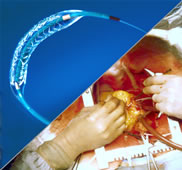|
Stents: Same Outcomes,
Less Money Than Surgery for Many Heart Patients
|
 |

Drug-eluting
stent and open heart
coronary artery bypass grafting |
|
March 28, 2009 --
Orlando, Florida -- For many patients
with triple-vessel or left main disease, drug-eluting stents
provide
similar outcomes
to bypass surgery
-- and for less money, according to data from the SYNTAX trial,
presented this morning to the i2 Summit at the American College
of Cardiology’s 58th annual scientific session.
For patients with the most severe level of disease, coronary
artery bypass graft (CABG) surgery remains the standard of care.
But for those with straight-forward or intermediate disease, stenting
provides equivalent outcomes at lower cost. |
The SYNTAX Trial
The SYNTAX Trial (Synergy Between
PCI With Taxus and Cardiac
Surgery) was sponsored by the stent manufacturer Boston Scientific.
SYNTAX
enrolled
1,800
patients
with
multivessel
and/or
left main disease. Patients were randomized: half went to surgery
(CABG); half were treated with Percutaneous Coronary
Intervention,
or
PCI, using Taxus drug-eluting stents. Initial
reports were made at the 2008 European Congress of Cardiology and TCT
meetings, and SYNTAX
was published
on
March
5, 2009 in the New
England Journal of Medicine. The
results, measured at one year, showed that bypass surgery had a lower
rate of Major Adverse Cardiac Events (MACE) than stenting. MACE
is defined
as
death, heart attack, stroke or revascularization -- a repeat procedure
for opening up blocked vessels. In the case of stents, the higher
MACE rates were driven primarily by the need for repeat procedures
-- 13.5% for stents vs. 5.9% for surgery -- although the stroke rate
during surgery was four times higher than for PCI
(2.2% vs. 0.6%). Interestingly, when revascularization
was excluded as part of the measure, there was no
difference between the outcomes of stenting
and surgery,
Comparative Effectiveness Research
Commenting on
this aspect of the SYNTAX Trial, during a New England Journal
of Medicine Roundtable,
Dr. Elizabeth
Nabel, Director of the
National
Heart, Lung, and Blood Institute (NHLBI) said:
"The trial design
actually stacked the cards against PCI intervention by combining
both
the hard end points (death, MI and stroke) and the soft end point
(the need for revascularization) into a combined primary endpoint.
In other words, the device manufacturer in some ways stacked
the cards against themselves.
"But the second important point
is that this study is an example of Comparative Effectiveness
Research which is receiving a lot of attention in Washington
DC these days. Comparative Effectiveness
Research is a rigorous evaluation of two different
types of treatments...towards the
same medical condition. And it evaluates the effectiveness
of both
those approaches. I think the industry is to be congratulated
for conducting this type of heads-on comparison in the manner
in which they did." |
|

Elizabeth
Nabel, MD |
Dr. Nabel continued: "It may be that what
we're coming down to is a discussion between the patient and the
medical
and surgical
team,
really focusing on patient preferences, complexity of coronary anatomy
and potential risks and benefits, depending upon their medical state
and their co-morbidities."
Stents and Surgery: Similar Quality of
Life
This morning's presentation at the ACC added
quality
of life
and
economic
data to the original SYNTAX equation. Researchers found that both
stenting and CABG improved the overall quality of life over one year
of follow-up. Although
chest pain (angina) relief was slightly better with CABG in some
cases, the stented patients reported feeling better overall and,
in the two month period following the procedure, stents patients recovered
their quality of life far more quickly. In the end, at one-year, the
results for both arms of the trial coincided with no significant difference.
Stents More Cost-Effective in Intermediate and
Lower Risk Patients
One of the major contributions of the SYNTAX Trial has been the development
of a sophisticated SYNTAX score for patients with multivessel disease,
which measures their risk and therefore informs both patients and physicians
as to
whether
stenting or surgery may be the better option. Dr. Cohen's presentation
broke down the costs of the treatment according to low, medium and
high risk patients and found that, for low risk patients, stenting
initially cost about $6,000 less than surgery, which reflected the
higher hospital costs and much higher physician fees for surgery. For
medium
risk patients, the difference was about $4,000. However, PCI added
approximately $2,500 in follow-up
costs over the next year, mostly because of additional heart
procedures and the need for long-term anti-clotting medication. In
the highest risk patients, those with the most complex anatomy and
most diffuse disease, the costs between surgery and stenting were not
statistically different.
No "One Size Fits All"
The presenter, Dr. David
J. Cohen, director of cardiovascular research at Saint-Luke’s Mid
America Heart Institute and a professor of medicine at the University
of Missouri, stated:
“The
data on quality of life will be helpful to physicians and patients
as they consider an appropriate course of treatment.
Long-term results will be essential to providing more definitive
guidelines for treating these complex coronary patients, and five-year
follow up is planned for all patients in the SYNTAX trial.
"The
most important message is that there is no single answer. The relative
cost-effectiveness
of PCI
and CABG
for
left
main and
three-vessel
disease depends strongly on the complexity of underlying coronary
disease."
Cost-Effectiveness A Moving Target
Dr. Cohen also pointed out that
the cost-effectiveness data was based on the U.S. healthcare system
and
these conclusions
may be
different in other countries. Additionally, as the cost for long-term
antiplatelet therapy is reduced (for example when Plavix, the brand-name
of clopidogrel, goes out of patent protection) the cost-effectiveness
of stenting
will increase.
As with all trials, the results can be a moving
target. While bypass surgery is a mature procedure and probably will
not change appreciably, newer stents, such as the XIENCE/PROMUS
have already come on the market since SYNTAX was done,
and they may reduce
the
revascularization
rate even further.
Realization of a 30 Year Dream
When Andreas Gruentzig first invented coronary angioplasty, using only
balloons, he thought perhaps a modest 5-10% of patients could be
helped by his procedure. He hoped for the day when angioplasty could
compete with surgery, offering patients a less invasive treatment
and, to that end, instituted rigorous registries and began the first
angioplasty vs. surgery comparison trial in the mid-80's. The vast
improvement both in equipment and the practice of interventional
cardiology has now expanded non-surgical treatment of coronary artery
disease
further.
Dr. Ted Feldman, Past President
of the SCAI and Director of the Cardiac Catheterization Laboratory
at Evanston Hospital (Chicago, Ill.) summed it up:
"We were all
excited to see the SYNTAX trial clinical results, demonstrating
that many patients
with left main and three-vessel coronary disease could be
offered stents when their only option in the past was bypass
surgery.
The comparable death and heart attack rates for stents and
surgery, and the lower stroke rate for stents, clearly demonstrate
the
safety of the less invasive alternative. To see now that
this can be done with less cost and equivalent or better
quality-of-life
measures in many patients is a powerful finding."
|
|

Ted Feldman,
MD |
Reported by Burt Cohen, March 28, 2009
|



